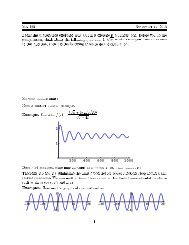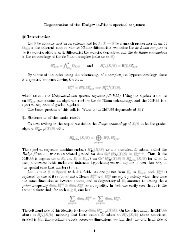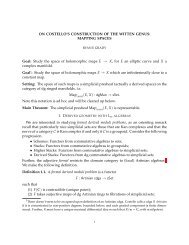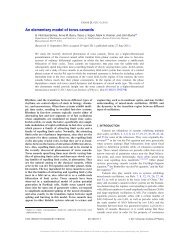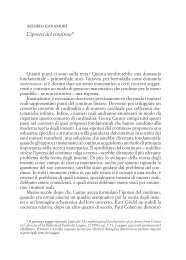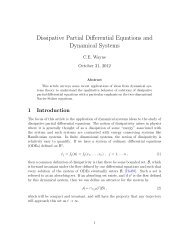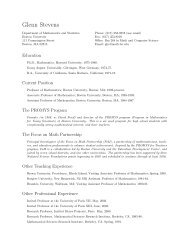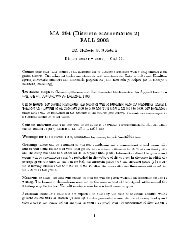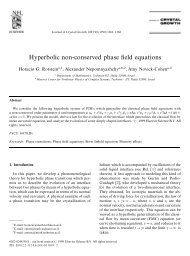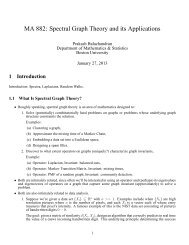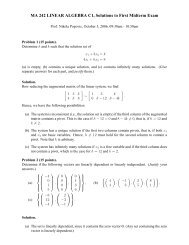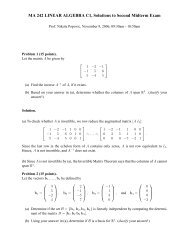Day 11-2: Convergence of Power Series
Day 11-2: Convergence of Power Series
Day 11-2: Convergence of Power Series
You also want an ePaper? Increase the reach of your titles
YUMPU automatically turns print PDFs into web optimized ePapers that Google loves.
1 <strong>Power</strong> <strong>Series</strong><br />
<strong>11</strong>-2: <strong>Convergence</strong> <strong>of</strong> <strong>Power</strong> <strong>Series</strong><br />
Prakash Balachandran<br />
Department <strong>of</strong> Mathematics<br />
Duke University<br />
March 23, 2010<br />
• Definition: A power series about x = a is a sum <strong>of</strong> constants times powers <strong>of</strong> (x − a) :<br />
C0 + C1(x − a) + C2(x − a) 2 + · · · + Cn(x − a) n + · · · =<br />
• In the definition <strong>of</strong> a power series, a is a constant.<br />
∞<br />
Cn(x − a) n .<br />
• For any fixed value <strong>of</strong> x, the power series ∞<br />
n=0 Cn(x − 1) n is a series <strong>of</strong> numbers as we’ve considered<br />
before. To investigate the convergence <strong>of</strong> a power series, we consider the partial sums Sn(x) = C0 +<br />
C1(x − 1) + · · · + Cn(x − a) n and ask whether for each fixed x, {Sn(x)} tends to some limit as n → ∞.<br />
• Recall the geometric series:<br />
n=0<br />
∞<br />
x n . (1)<br />
n=0<br />
This is a power series about x = 0 where Cj = 1 for every j.<br />
– Setting Sn(x) = n j=0 xj , we find that Sn(x) → 1 if −1 < x < 1.<br />
1−x<br />
– What if x = −1, 1?<br />
∗ If we plug in x = 1, then {Sn(1)} = {n + 1} which obviously increases without bound, and so<br />
the series diverges.<br />
∗ If we plug in x = −1 then {Sn(−1)} oscillates between 0 and 1 and so diverges.<br />
– Notice the convergence <strong>of</strong> this power series to a finite number is non-trivial: it converges to 1<br />
1−x only<br />
for −1 < x < 1. Can we develop theorems or tests that tell us when a general power series converges?<br />
• Example:<br />
– Determine whether the power series ∞ x<br />
n=0<br />
n<br />
2n converges or diverges for<br />
1. x = −1.<br />
∗ Plugging in x = −1, we find ∞ the series converges to<br />
1<br />
1−(− 1<br />
2)<br />
n=0<br />
= 2<br />
3 .<br />
1<br />
− 1<br />
2<br />
n 1<br />
which is a geometric series with ratio − . Thus, 2
2. x = 3.<br />
2 <strong>Convergence</strong><br />
∗ Plugging in x = 3, we find ∞ n=0<br />
Thus, the series diverges at x = 3.<br />
2.1 The Interval <strong>of</strong> <strong>Convergence</strong><br />
<br />
3 n<br />
which is a geometric series with ratio bigger than 1.<br />
2<br />
• In the previous section, we discussed convergence and divergence <strong>of</strong> power series. We noticed that, at least<br />
in the case <strong>of</strong> the geometric series, there was an interval in which it converged, but it didn’t converge at the<br />
endpoints. Is this a particular phenomenon <strong>of</strong> the geometric series, or does it hold in more generality?<br />
• Definitions:<br />
– If a power series converges only for x = a, then the radius <strong>of</strong> convergence is defined to be R = 0.<br />
– If the power series converges for all values <strong>of</strong> x, then the radius <strong>of</strong> convergence is defined to be<br />
R = ∞.<br />
– If the power series converges for values <strong>of</strong> x for which |x − a| < R, or a − R < x < a + R, then the<br />
radius <strong>of</strong> convergence is defined to be R.<br />
– The interval <strong>of</strong> convergence is the interval (a − R, a + R) including and endpoint where the power<br />
series converges.<br />
• In the case <strong>of</strong> the geometric series, ∞<br />
n=0 xn , the radius <strong>of</strong> convergence is 1, and the interval <strong>of</strong> convergence<br />
is (−1, 1).<br />
• As promised, we have a theorem that computes convergence over intervals::<br />
Theorem 1 (Method for Computing the Radius <strong>of</strong> <strong>Convergence</strong>) To compute the radius <strong>of</strong> convergence, R,<br />
for the power series ∞<br />
n=0 Cn(x − a) n , use the ratio test with an = Cn(x − a) n :<br />
1. If limn→∞ |an+1|<br />
|an|<br />
2. If limn→∞ |an+1|<br />
|an|<br />
3. If limn→∞ |an+1|<br />
|an|<br />
= ∞ then R = 0.<br />
= 0 then R = ∞.<br />
= K|x − a| where K is finite and nonzero, then R = 1<br />
K .<br />
4. If the limn→∞ |an+1|<br />
|an| fails to exist, then we don’t know anything.<br />
Pro<strong>of</strong>: <br />
∞<br />
Cn(x − a) n<br />
<br />
<br />
<br />
<br />
≤<br />
and we have that<br />
|an+1|<br />
lim<br />
n→∞ |an|<br />
n=0<br />
∞<br />
|Cn||x − a| n =<br />
n=0<br />
|Cn+1||x − a|<br />
= lim<br />
n→∞ |Cn|<br />
2<br />
∞<br />
|an|<br />
n=0<br />
|Cn+1|<br />
= |x − a| lim<br />
n→∞ |Cn|<br />
= L|x − a|.
So, depending on the value <strong>of</strong> L, the ratio test gives us when the power series converges. <br />
• Examples:<br />
1. Show that the power series<br />
converges for all values <strong>of</strong> x.<br />
– Cn = 1<br />
n!<br />
all x.<br />
⇒ limn→∞ |an+1|<br />
|an|<br />
1 + x + x2<br />
2!<br />
= |x| limn→∞ 1<br />
n+1<br />
+ · · ·<br />
2. Determine the radius and interval <strong>of</strong> convergence <strong>of</strong> the series<br />
– Cn = (−1)n−1<br />
n<br />
(x − 1) −<br />
(x − 1)2<br />
2<br />
+ (x − 1)3<br />
3<br />
|an+1|<br />
⇒ limn→∞ |an|<br />
is R = 1, and the interval <strong>of</strong> convergence is (0, 2).<br />
3. Find the interval <strong>of</strong> convergence <strong>of</strong> the series<br />
n−1 x2n−1<br />
– an = (−1) (2n−1)!<br />
every value <strong>of</strong> x.<br />
x − x3<br />
3!<br />
+ x5<br />
5!<br />
= |x − 1| limn→∞ n<br />
n+1<br />
− x7<br />
7!<br />
⇒ |an+1|<br />
|an| = x 2<br />
(2n+1)2n<br />
= 0, so that R = ∞. Thus, the series converges for<br />
n−1 (x − 1)n<br />
+ · · · + (−1) + · · ·<br />
n<br />
= |x − 1|. Thus, the radius <strong>of</strong> convergence<br />
x2n−1<br />
+ · · · + (−1)n−1 + · · ·<br />
(2n − 1)!<br />
→ 0 as n → ∞. Thus, the power series converges for<br />
• In the last example, the moral is: if some <strong>of</strong> the Cn are zero, rewrite the series and pick one in which the<br />
terms are nonzero.<br />
2.2 Endpoints <strong>of</strong> the Interval<br />
• The ratio test doesn’t tell us what happens to a power series at the endpoints <strong>of</strong> its interval <strong>of</strong> convergence.<br />
Often, we can just plug in x = a ± R and convert the power series to a series <strong>of</strong> numbers, and use the tests<br />
we already know to establish convergence/divergence at these endpoints.<br />
• Example: Look at the previous example (2). Does it converge at the end points?<br />
– Plugging in x = 2, we obtain the series 1 − 1 1 1 + − 2 3 4<br />
series, and so converges by the alternating series test.<br />
– Plugging in x = 0, we obtain the series −1 − 1<br />
2<br />
series, which diverges.<br />
3<br />
+ · · · + (−1)n−1<br />
n<br />
+ · · · which is an alternating<br />
1 1<br />
1<br />
− − − · · · − − · · · which is a negative harmonic<br />
3 4 n



